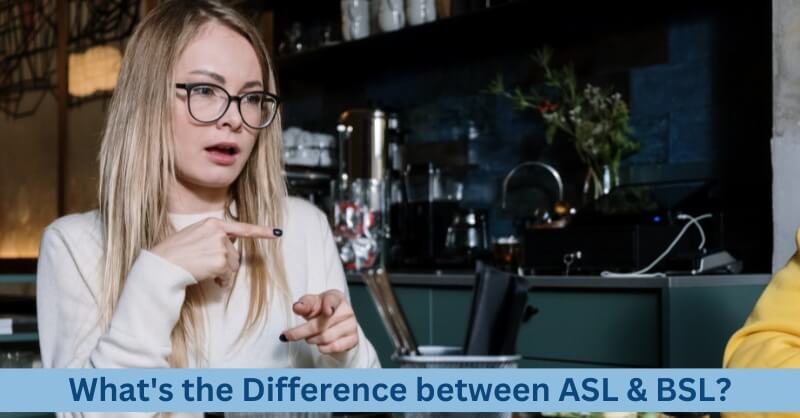
Individuals who are deaf or hard of hearing rely on sign language to communicate. ASL and (BSL) are two sign languages that are widely used around the world. Your desire to know about the differences between ASL and BSL is quite interesting. But to know the specific answer, you must look into the details. As we can see, thousands of languages are used over the world, just sign languages are not global. Between 138 and 300 different types of sign, languages are used worldwide today. That is not the end of it. New sign languages are frequently evolving among deaf children and adults. ASL and BSL are two sign languages. Other languages include French, Chinese, Irish, Brazilian, and Indo-Pakistan sign language. Let’s dive in to learn more about these languages.
Sign Language Does not Represent Spoken Language
You must be thinking that spoken languages inspire that sign language. But the exciting part is, it’s not! Sign languages grow from conversations with others rather than from a country’s spoken language. Although the fact that both the US and the UK speak English, their sign languages are significantly different.

Sign Languages Have Their Own Grammar
Like spoken and written languages, sign language has grammar to make meaningful sentences. Every sign language has guidelines for creating coherent sentences. For example, sign language makes use of the region in front of the signer as well as the right level of brow posture. They use spaces to show who did what to whom by pointing. However, some verbs indicate both the subject and object of the verb, some point only to the thing, and some don’t. Eyebrows should be down for who-what-where-when-why queries and up for yes/no questions. If you use the rules incorrectly or inconsistently, you will have a “foreign” accent! Every individual takes time to adopt sign language. And through the time being, they develop various insights. Babies start by “babbling” with their hands. When babies start making important signals, their hand shapes become more challenging, resulting in “cute” baby spellings.
ASL or America Sign Language
American Sign Language (ASL) is largely a visual language used by the Deaf community. It is mainly used in the US and parts of Canada and, to a small extent, in West Africa and Southeast Asia. ASL is the native sign language of around 250,000-500,000 persons in the United States, which is a sizable amount. Alabama, Colorado, Georgia, Indiana, Maine, Massachusetts, Montana, Oklahoma, Rhode Island, and Utah are the 10 states in America that legally accept ASL as the official language of deaf people. Some experts believe that ASL is developed based on French Sign Language. Yet, Martha’s Vineyard Sign Language and other local sign languages were also influential. American Sign Language, or ASL, has its syntax and grammar rules. It changes over time and has common linguistic properties like other languages. ASL consists of various kinds of facial expressions, specific signals, body motions, physical space use, one-handed fingerspelling, and signs that depend on hand shape, palm orientation, location, and direction.
British Sign Language (BSL) Level 1 & 2
British Sign Language (BSL) Level 1 & 2
BSL or British Sign Language
It is a visual language used mostly by the deaf community in England, Scotland, Wales, and Northern Ireland, like ASL and BSL. In the UK, there are about 150,000 users of British Sign Language. Thomas Braidwood’s deaf schools generated this highly ancient sign language in the late 1700s and early 1800s. Then it spread to New Zealand and Australia. Auslan (Australian Sign Language) and New Zealand Sign Language are quite similar in that they employ the same syntax, manual alphabet, and a large amount of the same vocabulary. Once more, some sign language specialists assert that BSL, Auslan, and New Zealand Sign Language are all dialects of the same sign language, which is known as British, Australian, and New Zealand Sign Language, or BANZSL. Despite their significant similarities, the various branches of the BANZSL family differ. Mori terms, for instance, are used in New Zealand Sign Language. It also includes signs from Australasian Sign Language, which was used in New Zealand schools for deaf students in the 1980s. In the beginning, Auslan also included some signs derived from Irish Sign Language. Indigenous Australians who are deaf may use Auslan or a sign language unrelated to Auslan. Far North Queensland dialect has elements of these indigenous sign languages as well.

ASL and BSL are Different Languages
They have a long list of differences. But the most significant difference between ASL and BSL is using a one-handed manual alphabet in ASL and a two-handed one in BSL. ASL is completely different from BSL in terms of the alphabet and numbers. For example, the vowels in BSL are made with your thumb and four fingers, and the remainder of the alphabet is mostly done with two hands. But, the vowels in ASL and the rest of the alphabet are done with one hand. Despite some word overlap and sign similarities, ASL and BSL are fundamentally independent sign languages. The people using ASL and BSL cannot be understood by each other’s users. Even after importing language components or vocabulary from one another, ASL and BSL remain highly special. Another big difference is that ASL has a lot of fingerspelling, whereas BSL users mainly use it for proper nouns such as names and places – when first said. But once you’ve given the word, use someone’s signed name or initial it in case they don’t have one. Place names tend to have signs to mean it- some are obvious, but others require local knowledge to understand the origin. Sign languages are the practice of using proper grammatical elements, vocabulary, and colloquialisms.
British Sign Language (BSL) Level 1 & 2
British Sign Language (BSL) Level 1 & 2
Conclusion
ASL and BSL are two distinct sign languages used by deaf communities in different parts of the world. One significant difference lies in their linguistic structure. ASL is based on French Sign Language (LSF), whereas BSL is developed independently. As a result, the two languages have different grammatical structures and vocabulary. ASL, for example, employs a subject-comment structure in which the issue is introduced first and then elaborated on. In contrast, BSL follows a subject-verb-object structure similar to spoken English.
Culturally, ASL and BSL reflect the unique communities in which they are used. In the United States, ASL has been influenced by a range of cultural groups, including African American, Native American, and Hispanic cultures. It has a strong presence in the American deaf community and has evolved over time. BSL, on the other hand, is rooted in British culture and reflects the linguistic heritage of the United Kingdom.
FAQs
1. Is ASL easier to learn than BSL, or vice versa?
It largely depends on the learner’s native language and their learning style.
2. Can an ASL user communicate efficiently with a BSL user?
Due to significant syntax, grammar, and vocabulary differences, an ASL user might need help to communicate with a BSL user and vice versa.
3. Are there any sign languages that are universally understood?
No, sign languages are not universal. They vary from region to region, much like spoken languages.
4. How many people use ASL and BSL worldwide?
As of my knowledge, cut-off in September 2021, ASL is used by approximately 500,000 to 2 million people, primarily in the US and Canada. BSL is used by an estimated 151,000 adults in the UK.
5. Can a person who knows ASL understand BSL (and vice versa)?
Not necessarily. Although there may be some similar signs, the majority are pretty different.











Great explained difference between ASL & BSL.